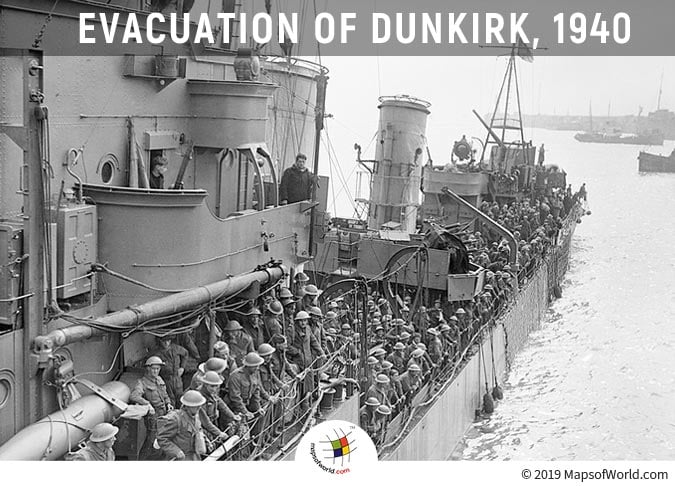

Dunkirk is Located in France’s North, Close to the Belgian-French Border.
Dunkirk (called Dunkerque in French) is a highly historically significant place. It was here that a huge military campaign was carried out during World War II. In just a matter of few days (from May 26 to June 4, 1940) about 338,000 BEF (British Expeditionary Force) and Allied troops were evacuated from Dunkirk, France to England so as to avoid German forces that were increasingly closing in on them. This whole operation was labeled the “Miracle of Dunkirk.”
Dunkirk is in France’s north, close to the Belgian-French border. The Strait of Dover is in the southwest, where across the English Channel, the distance between France and England is only 21 miles. Dunkirk is near to the three European powers’ borders, which made it a popular site for commerce for centuries.
In a blitzkrieg attack, Nazi Germany conquered Belgium, Luxembourg, and the Netherlands in May 1940. The three countries easily gave up in front of the superior military powers of Germany. Unexpectedly, Germany was invading France moving through Ardennes Forest instead of along the Maginot Line. As the Germans advanced, the allied troops moved to the north, shifting more and more into a small region in the French coast. Fearing a certain defeat at the hands of Nazi troops, BEF commander General John Gort came around a decision to evacuate the region through the sea with his entire force.
At Dover, ships started gathering. Unnecessary personnel were ordered to evacuate. The actual evacuation began on 26 May under the direction of Vice Admiral Bertram Ramsay, with the codename Operation Dynamo. The evacuation team was working in a room located deep inside the Dover cliffs. It once had dynamo named generator located there, hence the curious codename. The evacuation process got slowed down due to the bombing attacks by the Luftwaffe. The RAF (Royal Air Force) however tried in their capacity to stop the attacking planes and lost many aircraft during that time.
On the evacuation’s first day, around 7,500 men got out from Dunkirk. On the following day, May 27, 15,000 more were evacuated. Since the beach was shallow at Dunkirk, Royal Navy vessels weren’t able to reach them. Therefore, a call was put out for smaller ships in order to carry the troops to larger ships from the shore. Between 800 to 1,200 boats, many of which were fishing or leisure crafts, came forward to help. Some were manned by civilian owners and others by naval personnel. The first batch of this armada came to be known as the ‘Little Ships.’ On May 28, they began arriving on Dunkirk’s beaches, speeding up the process of evacuation.
In the beginning, it was estimated that in total only around 45,000 men would be rescued. However, the operation turned out to be a huge success. By May 27, over 47,000 troops had been evacuated and by May 30, over 53,000 troops were rescued. In the end, a total of 140,000 French and 198,000 British troops managed to evacuate from Dunkirk, constituting about some 338,000 men. On June 4, German troops reached Dunkirk and occupied it.
Related Links:
The Republic of Madagascar is an island country located in the Indian Ocean, off the…
The Euro is the official currency of the European Union. It is, however, not incumbent…
There are many countries or regions that are partially recognized by the UN, have disputes…
The Alaska Statehood Act was signed into law by President Dwight D. Eisenhower in 1958,…
The name Persia may, however, only be used to refer to Iran in some contexts.…
Hawaii is an Island State in the US. It is one of the 50 states…